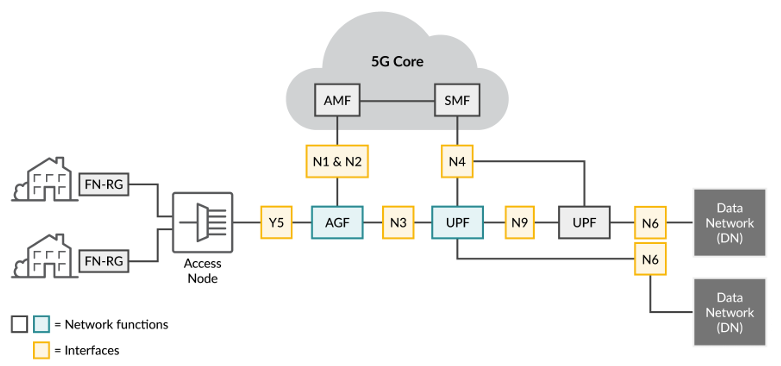5G delivers higher data speeds, and lower latency, and supports more users, devices, and services while simultaneously improving network efficiency. As defined by the Third-Generation Partnership Project (3GPP), the 5G core (5GC) network is a cloud-aligned, service-based architecture (SBA) and covers all 5G functions and interactions.
The converged 5GC lays the foundation for a single subscriber profile and policy management for both the existing wireline users with installed router gateway and the new 5G wireless users. The converged core offers the following benefits:
- Single control plane for wireline and wireless subscribers.
- Ease of migration for existing subscribers to 5GC.
- Access to a wireline fixed network router gateway (FN-RG).
- Hybrid access with a 5G residential gateway (5G-RG) for increased bandwidth and increased availability.
- Single Operation Support System (OSS) and Business Support System (BSS) integration.
What is Access Gateway Function (AGF)?
The Access Gateway Function (AGF) definition is the result of a joint initiative between the Broadband Forum (BBF) and the GSMA’s 3rd Generation Partnership Project (3GPP). BBF technical report TR-456 specifies the AGF functional requirements, while the 3GPPs technical specification TS 23.316 is the companion document detailing wireless and wireline convergence (WWC) access support for the 5G system.
The Access Gateway Function (AGF) is a function that provides connectivity from a wireline Access Network to the 5G Core Network. Access Gateway Function (AGF) is the access point for subscribers, through which they connect to the internet and private networks. It provides critical subscriber management functions, such as authentication, IP address assignment, bandwidth allocation, and accounting.
When a connection is established between the Customer Premises Equipment (CPE) and the AGF network function, the subscriber can access the broadband services provided by the telecom operator or Internet Service Provider (ISP). The role of the AGF is to aggregate traffic from various subscriber sessions from an access network and route it to the network of the service provider.

Benefits of Access Gateway Function
- Offers ease of migration for a subscriber with existing customer premise equipment (CPE), such as an FN-RG, to the 5G core (5GC).
- Provides a solution that enables interworking between wireline devices and the 5GC.
- Supports existing Fixed Network Residential Gateway (FN-RG) and existing hardware, such as the MX series routers.
- Optimizes data plane traffic with the User Plane Function (UPF), resulting in improved performance.
- Eases deployment by enabling the collocation of broadband network gateway (BNG), AGF, and UPF on the same platform.
What is a Fixed Network Residential Gateway (FN-RG)?
FN-RG is a wireline device that works in a wireline network. It does not send signaling associated with RAN found in 5GC networks. For an FN-RG, N1 signaling originates on the AGF. The AGF acts as an endpoint on the 5GC and handles all N1 signaling on behalf of the FN-RG. You do not need new hardware or changes to the existing FN-RG hardware to work with AGF.
What is N1?
Interface from the user equipment (UE) to the AMF. The N1 interface uses non-access stratum (NAS) layer signaling to exchange UE information that is related to the connection and session that the UE establishes with the 5GC network.
